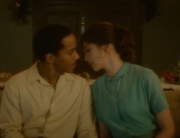This review was originally posted on March 17, 2022.
If the SXSW Film Festival gave an award for Best Bait and Switch, the winner would be, hands down, the beguiling Finnish film The Blind Man Who Did Not Want to See Titanic. The playful title is in keeping with the movie’s first half, which starts out as a day in the life of fortyish Jaakko, who is blind as a result of multiple sclerosis and uses a wheelchair to navigate his apartment, where he lives alone. (Lead actor Petri Poikolainen, a stand-out, has the same disease as his character.) He’s a film nerd, a fervent fanboy for Stephen King, pre-1990s John Carpenter, and pre–Titanic James Cameron. Among the nicknames he gives his patient caregiver (Hannamaija Nikander), who comes a few times a week, is Annie Wilkes, courtesy of Misery.
Jaakko has met Sirpa (Marjaana Maijala), a woman who has vasculitis, online, and they call each other several times a day. The handheld camerawork and constant closeups of Jaakko, from all angles, immediately create a sense of intimacy between viewers and the protagonist from the outset—it may take a moment or two to realize that the initial conversation isn’t a private moment in a documentary.
In one of the daily phone calls, Sirpa reveals she will need to undergo chemotherapy. In a spur-of-the-moment decision, Jaakko decides to leave town and schlep by taxi to the train and then grab another cab to her home. This would be the first time they will meet face to face. The journey’s also a deliberate strike for more freedom; that same day, his mom and dad want to take him out to a park for ice cream.
However, because the train departure is in less than 24 hours, he cannot reserve a guide. He is left on his own, dependent upon the kindness of strangers, and let’s just say that not everyone has the best of intentions regarding his health or safety. The film nimbly becomes a thriller without shedding its established rhythm—it’s Jaakko’s circumstances that abruptly change. Before you know it, the tone has turned uncomfortably ominous.
The camera remains by Jaakko’s side while everything at the edge and beyond the frame remains blurry, whether he’s at home or venturing out on his own, perhaps as a way to simulate his blindness. The focus on his moment-to-moment reactions, at the expense of everyone else, makes writer/director Teemu Nikki’s choice to closely follow Jaakko an easy gateway for audience identification. The overall result is an inventive example of low-budget filmmaking; any financial limitations actually enhance the entire movie.







Leave A Comment